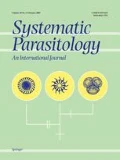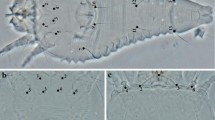Abstract
Among monogeneans, haptoral hard parts provide prominent morphological characters upon which identifications are largely based. Traditionally, morphometric approaches are based on the use of arbitrary collections of linear distance measurements between landmarks. An exhaustive review of the specific diagnoses published in the journal Systematic Parasitology highlights the fact that an intricately important number of measurements are used to describe the same morphological features. Hence, this does not allow relevant comparison between studies and may have caused confusion in the literature. More importantly, a significant proportion of diagnoses commonly used do not maximize the amount of information available from morphological features, and sets of linear measurements between landmarks do not properly allow the complete reconstruction of the shape of haptoral hard parts. Given this prominent bias and the disparate use of traditional methodologies, I suggest the use of alternative methods in systematic parasitology that fully take into consideration the shape of morphological features. In addition to these considerations, a move toward placing shape at the centre of automated species recognition would be mutually beneficial for both taxonomists and non-taxonomists.








Similar content being viewed by others
References
Adams, D. C., Rohlf, F. J., & Slice, D. E. (2002). Geometric morphometrics: ten years of progress following the ‘revolution’. Italian Journal of Zoology, 71, 5–16.
Bookstein, F. L. (1997). Landmark methods for forms without landmarks: localizing group differences in outline shape. Medical Image Analysis, 1, 225–243.
Dayrat, B. (2005). Towards integrative taxonomy. Biological Journal of the Linnean Society, 85, 407–415.
Dmitrieva, E. V., Gerasev, P. I., Merella, P., & Pugachev, O. N. (2009). Redescriptions of Ligophorus cephali Rubtsova, Balbuena, Sarabeev, Blasco-Costa, Euzet, 2006, L. chabaudi Euzet & Suriano, 1977 (Monogenea: Ancyrocephalidae), with notes on the functional morphology of the copulatory organ. Systematic Parasitology, 73, 175–191.
Dmitrieva, E. V., Gerasev, P. I., & Pron’kina, N. V. (2007). Ligophorus llewellyni n. sp. (Monogenea: Ancyrocephalidae) from the redlip mullet Liza haematocheilus (Temminck & Schlegel) introduced into the Black Sea from the Far East. Systematic Parasitology, 67, 51–64.
Du Preez, L. H., & Maritz, M. F. (2006). Demonstrating morphometric protocols using polystome marginal hooklet measurements. Systematic Parasitology, 63, 1–15.
Ernst, I., Whittington, I. D., & Jones, M. K. (2000). Three new species of Polyclithrum Rogers, 1967 (Gyrodactylidae: Monogenea) from mugilid fishes from Australia and Brazil, with a redescription of P. mugilini Rogers, 1967. Systematic Parasitology, 45, 61–73.
Galli, P., Strona, G., Maria Villa, A., Benzoni, F., Fabrizio, S., Maria Doglia, S., & Kritsky, D. C. (2006). Three-dimensional imaging of monogenoidean sclerites by laser scanning confocal fluorescence microscopy. Journal of Parasitology, 92, 395–399.
Galli, P., Strona, G., Maria Villa, A., Benzoni, F., Stefani, F., Maria Doglia, S., & Kritsky, D. C. (2007). Two-dimensional versus three-dimensional morphometry of monogenoidean sclerites. International Journal for Parasitology, 37, 449–456.
Gaston, K. J., & O’Neill, M. A. (2004). Automated species identification: why not? Philosophical Transactions of the Royal Society B, 359, 655–667.
Gussev, A. V. (1976). Freshwater Indian Monogenoidea. Principles of systematics, analysis of the world faunas and their evolution. Indian Journal of Helminthology, 25–26, 1–241.
Haines, A. J., & Crampton, J. S. (2003). Improvements to the method of Fourier shape analysis as applied in morphometric studies. Palaeontology, 43, 765–783.
Harris, P. D., Shinn, A. P., Cable, J. T., Bakke, A., & Bron, J. (2008). GyroDb: gyrodactylid monogeneans on the web. Trends in Parasitology, 24, 109–111.
Kuhl, F. P., & Giardina, C. R. (1982). Elliptic Fourier features of a closed contour. Computer Graphics and Image Processing, 18, 236–258.
La Salle, J., Wheeler, Q., Jackway, P., Winterton, S., Hobern, D., & Lovell, D. (2009). Accelerating taxonomic discovery through automated character extraction. Zootaxa, 2217, 43–55.
MacLeod, N. (1999). Generalizing and extending the eigenshape method of shape visualization and analysis. Paleobiology, 25, 107–138.
MacLeod, N. (Ed.). (2007). Automated taxon identification in systematics - theory, approaches and applications. Systematics Association Special Volume 74. Boca Raton: CRC Press, London, 368 pp.
McHugh, E. S., Shinn, A. P., & Kay, J. W. (2000). Discrimination of the notifiable pathogen Gyrodactylus salaris from G. thymalli (Monogenea) using statistical classifiers applied to morphometric data. Parasitology, 121, 315–323.
Murith, D., & Beverley-Burton, M. (1985). Salsuginus Beverley-Burton, 1984 (Monogenea: Ancyrocephalidae) from Cyprinodontoidei (Atheriniformes) in North America with description of Salsuginus angularis (Mueller, 1943) Beverley-Burton, 1984 from Fundulus diaphanus and Salsuginus heterocliti n. sp. from F. heteroclitus. Canadian Journal of Zoology, 63, 703–714.
Olstad, K., Bachmann, L., & Bakke, T. A. (2009). Phenotypic plasticity of taxonomic and diagnostic structures in gyrodactylosis-causing flatworms (Monogenea, Platyhelminthes). Parasitology, 136, 1305–1315.
Page, R. D. M. (1994). Maps between trees and cladistic analysis of historical associations among genes, organisms, and areas. Systematic Biology, 43, 58–77.
Rehulková, E., & Gelnar, M. (2005). A revised diagnosis of Thylacicleidus (Monogenea: Dactylogyridae) with a redescription of the type species, Thylacicleidus serendipitus, and description of two new species from southeast Asian pufferfishes (Tetraodontiformes: Tetraodontidae). Journal of Parasitology, 91, 794–807.
Robertsen, G., Hansen, H., Bachmann, L., & Bakke, T. A. (2007). Arctic charr (Salvelinus alpinus) is a suitable host for Gyrodactylus salaris (Monogenea, Gyrodactylidae) in Norway. Parasitology, 134, 257–267.
Rohlf, F. J., & Marcus, L. F. (1993). A revolution in morphometrics. Trends in Ecology and Evolution, 8, 129–132.
Shinn, A. P., des Clers, S., Gibson, D. I., & Sommerville, C. (1996). Multivariate analyses of morphometrical features from Gyrodactylus spp. (Monogenea) parasitising British salmonids: Light microscope based studies. Systematic Parasitology, 33, 115–125.
Shinn, A. P., Hansen, H., Olstad, K., Bachmann, L., & Bakke, T. A. (2004). The use of morphometric characters to discriminate specimens of laboratory-reared and wild populations of Gyrodactylus salaris and G. thymalli (Monogenea). Folia Parasitologica, 51, 239–252.
Slice, D. E. (2007). Geometric morphometrics. Annual Review of Anthropology, 36, 261–281.
Strauss, R. E., & Bookstein, F. L. (1982). The truss: body form reconstruction in morphometrics. Systematic Zoology, 31, 113–135.
Vignon, M. (2011). Inference in morphological taxonomy using collinear data and small sample sizes: Monogenean sclerites (Platyhelminthes) as a case study. Zoologica Scripta, 40, 306–316.
Vignon, M., Pariselle, A., & Vanhove, M. (2011). Modularity in attachment organs of African Cichlidogyrus (Platyhelminthes, Monogenea, Ancyrocephalidae) reflects phylogeny rather than host specificity or geographic distribution. Biological Journal of the Linnean Society, 102, 694–706.
Vignon, M., & Sasal, P. (2010). The use of geometric morphometrics in understanding shape variability of sclerotized haptoral structures of monogeneans (Platyhelminthes) with insights into biogeographic variability. Parasitology International, 59, 183–191.
Acknowledgement
The author is grateful to two anonymous reviewers who made highly valuable comments to improve the manuscript and provided their enlightened taxonomists’ point of view.
Author information
Authors and Affiliations
Corresponding author
Rights and permissions
About this article
Cite this article
Vignon, M. Putting in shape – towards a unified approach for the taxonomic description of monogenean haptoral hard parts. Syst Parasitol 79, 161–174 (2011). https://doi.org/10.1007/s11230-011-9303-1
Received:
Accepted:
Published:
Issue Date:
DOI: https://doi.org/10.1007/s11230-011-9303-1




